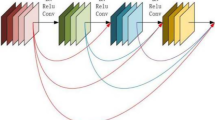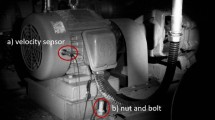Abstract
Gear is one of the popular and important components in the rotary machinery transmission. Vibration monitoring is the common way to take gear feature extraction and fault diagnosis. The gear vibration signal collected in the running time often reflects the characteristics such as non-Gaussian and nonlinear, which is difficult in time domain or frequency domain analysis. This paper proposed a novel gear fault feature extraction method based on hybrid time–frequency analysis. This method combined the Mexican hat wavelet filter de-noise method and the auto term window method at the first time. This method can not only de-noise noise jamming in raw vibration signal, but also extract gear fault features effectively. The final experimental analysis proved the feasibility and the availability of this new method.





Similar content being viewed by others
References
Hussain S, Gabbar HA (2011) A novel method for real time gear fault detection based on pulse shape analysis. Mech Syst Signal Process 25(4):1287–1298
Yesilyurt I (2003) Fault detection and location in gears by the smoothed instantaneous power spectrum distribution. NDT E Int 36(7):535–542
Liu W, Tang B (2011) A hybrid time–frequency method based on improved Morlet wavelet and auto terms window. Expert Syst Appl 38(6):7575–7581
Chen HG, Yan YJ, Jiang JS (2007) Vibration-based damage detection in composite wingbox structures by HHT. Mech Syst Signal Process 21(1):307–321
Rafiee J, Rafiee MA, Tse PW (2010) Application of mother wavelet functions for automatic gear and bearing fault diagnosis. Expert Syst Appl 37(6):4568–4579
Giagopulos D, Salpistis C, Natsiavas S (2006) Effect of non-linearities in the identification and fault detection of gear-pair systems. Int J Non Linear Mech 41(2):213–230
Jiang Y, Tang B, Qin Yi, Liu W (2011) Feature extraction method of wind turbine based on adaptive Morlet wavelet and SVD. Renew Energy 36(8):2146–2153
Kar C, Mohanty AR (2006) Monitoring gear vibrations through motor current signature analysis and wavelet transform. Mech Syst Signal Process 20(1):158–187
Cheng J, Yu D, Tang J, Yang Y (2008) Application of frequency family separation method based upon EMD and local Hilbert energy spectrum method to gear fault diagnosis. Mech Mach Theory 43(6):712–723
Ricci R, Pennacchi P (2011) Diagnostics of gear faults based on EMD and automatic selection of intrinsic mode functions. Mech Syst Signal Process 25(3):821–838
Yang Y, He Y, Cheng J, Yu D (2009) A gear fault diagnosis using Hilbert spectrum based on MODWPT and a comparison with EMD approach. Measurement 42(4):542–551
Al-Raheem KF, Roy A, Ramachandran KP et al (2009) Rolling element bearing faults diagnosis based on autocorrelation of optimized: wavelet de-noising technique. Int J Adv Manuf Technol 3–4(40):393–402
Plonka G, Tenorth S, Rosca D (2011) A new hybrid method for image approximation using the easy path wavelet transform. IEEE Trans Image Process 20(2):372–381
Srinivas HK, Srinivasan KS, Umesh KN (2010) Role of an artificial neural network and a wavelet transform for condition monitoring of the combined faults of unbalance and cracked rotors. Int J Acoust Vib 15(3):121–127
Shark L-K, Yu C (2006) Design of matched wavelets based on generalized Mexican-hat function. Signal Process 86(7):1451–1469
Baoping T, Wenyi L, Song T (2010) Wind turbine fault diagnosis based on Morlet wavelet transformation and Wigner–Ville distribution. Renew Energy 35(12):2862–2866
Pachori RB, Sircar P (2005) A novel technique to reduce cross terms in the squared magnitude of the wavelet transform and the short-time Fourier transform. In: Proceedings of IEEE international workshop on intelligent signal processing, Faro, Portugal, 1–3 September, pp 217–222
Mirela B, Isar A (2003) The reduction of interference terms in the time–frequency plane. Signals Circuits Syst 2:461–464
Lerga J, Sucic V (2009) Nonlinear IF estimation based on the pseudo WVD adapted using the improved sliding pairwise ICI rule. IEEE Signal Process Lett 16(11):953–956
Rajshekhar G, Gorthi SS, Rastogi P, (2009) Polynomial Wigner–Ville distribution-based method for direct phase derivative estimation from optical fringes. J Opt A Pure Appl Opt 11(12):125402–125412
Acknowledgments
This research was supported by the Scientific research support project for teachers with doctor’s degree, Jiangsu normal university, China (Grant No. 11XLR15), the National Natural Science Foundation of China (Grant Nos. 51075347 and 51305179), the Natural Science Foundation of the Jiangsu Higher Education Institutions (Grant No. 13KJB510009).
Author information
Authors and Affiliations
Corresponding author
Rights and permissions
About this article
Cite this article
Liu, W., Han, J. & Lu, X. A new gear fault feature extraction method based on hybrid time–frequency analysis. Neural Comput & Applic 25, 387–392 (2014). https://doi.org/10.1007/s00521-013-1502-z
Received:
Accepted:
Published:
Issue Date:
DOI: https://doi.org/10.1007/s00521-013-1502-z




